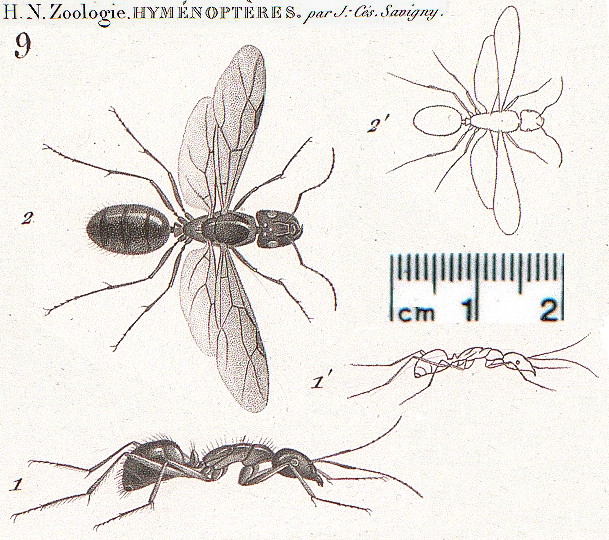Camponotus
(Tanaemyrmex) maculatus
(Fabricius)
 Type location West
Africa (Formica maculata, Fabricius, 1782:
491, worker; Mayr, 1862: 654, queen & male; Donisthorpe, 1915a:
221, redescription of the type); Wheeler (1922) reported the location
as "in Africa aequinoctali" adding probably Sierra Leone Type location West
Africa (Formica maculata, Fabricius, 1782:
491, worker; Mayr, 1862: 654, queen & male; Donisthorpe, 1915a:
221, redescription of the type); Wheeler (1922) reported the location
as "in Africa aequinoctali" adding probably Sierra Leone  . .
|
The original
Fabricius (1793) description is at  . Lepeletier de Saint-Fargeau (1835:
213) gave a description, this is at . Lepeletier de Saint-Fargeau (1835:
213) gave a description, this is at  .
Mayr (1862: 654) gave a further description which is at .
Mayr (1862: 654) gave a further description which is at  . .
Note: Forel
(1891b: 29ff) gave a description, this is at  .
This, however, was stated as being of C. maculatus liocnemis
by Emery (1905d: 30). Forel, for instance, gave the base colour as
black rather than dark brown. .
This, however, was stated as being of C. maculatus liocnemis
by Emery (1905d: 30). Forel, for instance, gave the base colour as
black rather than dark brown.
Because of the
complexity of the, mostly sub-Saharan forms attributed to C . maculatus, please visit http://antsofafrica.org/ant_species_2012/camponotus/camponotus_maculatus/camponotus_maculatus.htm
|
|

Egypt records - possibly not found as niche
filled by C. aegyptiacus; Karavaiev (1911: 10) reported finding
major and minor workers and wingless queens from Cairo but he noted the
queens had parallel sided heads matching the type queens in Emery
(1908a: 192).
However, Sharaf list - Abuzabal (Qalyubiya), 13.vi.2003 (2); Abuzabal
(Qalyubiya), 14.vi.2003 (1); Abuzabal (Qalyubiya), 14.v.2003 (1) (SHC).
Local distribution: Nagh Hammadi, Salloum, Kantara.
From Egypt, however, it may be that it was illustrated by
Savigny (Audouin, J.-V. 1825-27: Plate 20 Fig 9). The queen,
however, is smaller and more slender, with shorter scapes, than the
queens shown on the linked Ants of Africa pages.
The minor, assuming Savigny's scale is correct (the
other species
drawings on Plate 20, confirm the accuracy of his drawings), also is
not C. maculatus but seems
likely to be Camponotus
(Tanaemyrmex) fellah.
|
|

